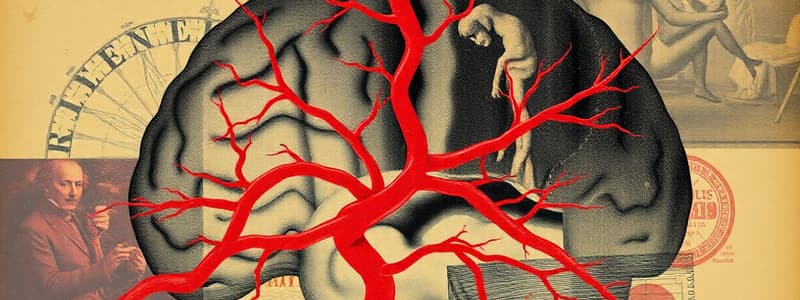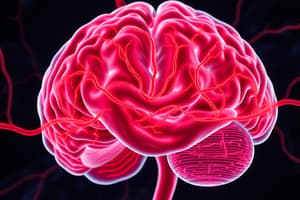Podcast
Questions and Answers
What is the primary function of autoregulation in cerebral blood flow?
What is the primary function of autoregulation in cerebral blood flow?
- To maintain a constant pH level in the brain.
- To regulate the diameter of cerebral blood vessels. (correct)
- To increase the quantity of oxygen transported in the blood.
- To enhance the permeability of the blood-brain barrier.
Which condition results from excessive blood flow to the brain?
Which condition results from excessive blood flow to the brain?
- Cerebral edema
- Ischemia
- Hyperemia (correct)
- Vasodilation
At what minimum blood flow rate to the brain does tissue death begin to occur?
At what minimum blood flow rate to the brain does tissue death begin to occur?
- 8 ml per 100 g per minute (correct)
- 18 ml per 100 g per minute
- 20 ml per 100 g per minute
- 10 ml per 100 g per minute
Which arteries unite to form the basilar artery in the skull?
Which arteries unite to form the basilar artery in the skull?
What role does the blood-brain barrier serve in the central nervous system?
What role does the blood-brain barrier serve in the central nervous system?
Which type of molecules can easily cross the blood-brain barrier?
Which type of molecules can easily cross the blood-brain barrier?
What is the main purpose of the Circle of Willis in cerebral circulation?
What is the main purpose of the Circle of Willis in cerebral circulation?
Which statement is true regarding the transport mechanisms of the blood-brain barrier?
Which statement is true regarding the transport mechanisms of the blood-brain barrier?
Which of the following is a function of the hypothalamus?
Which of the following is a function of the hypothalamus?
What is the primary role of the thalamus in the brain?
What is the primary role of the thalamus in the brain?
Which statement best describes the limbic system?
Which statement best describes the limbic system?
What function does cerebrospinal fluid (CSF) primarily serve?
What function does cerebrospinal fluid (CSF) primarily serve?
How does the brain regulate cerebral blood flow?
How does the brain regulate cerebral blood flow?
Which function is primarily associated with the hypothalamus?
Which function is primarily associated with the hypothalamus?
What is the main role of the thalamus in the brain?
What is the main role of the thalamus in the brain?
Which statement best describes the limbic system?
Which statement best describes the limbic system?
What is one of the primary functions of cerebrospinal fluid (CSF)?
What is one of the primary functions of cerebrospinal fluid (CSF)?
Cerebral blood flow is primarily regulated by which factors?
Cerebral blood flow is primarily regulated by which factors?
What effect does damage to the frontal lobe typically have?
What effect does damage to the frontal lobe typically have?
The Glasgow coma scale is primarily used to evaluate which aspect?
The Glasgow coma scale is primarily used to evaluate which aspect?
Which bodily function is NOT associated with the functions of the hypothalamus?
Which bodily function is NOT associated with the functions of the hypothalamus?
What type of assessment is included in a neurological exam?
What type of assessment is included in a neurological exam?
What behavioral outcome might result from occipital lobe damage?
What behavioral outcome might result from occipital lobe damage?
Which function is NOT typically attributed to the hypothalamus?
Which function is NOT typically attributed to the hypothalamus?
What is the primary role of the thalamus within the central nervous system?
What is the primary role of the thalamus within the central nervous system?
Which of the following best describes the function of the limbic system?
Which of the following best describes the function of the limbic system?
What role does cerebrospinal fluid (CSF) play in brain function?
What role does cerebrospinal fluid (CSF) play in brain function?
Which mechanism is involved in regulating cerebral blood flow?
Which mechanism is involved in regulating cerebral blood flow?
In relation to the limbic system, which structure is primarily responsible for the formation of spatial memories?
In relation to the limbic system, which structure is primarily responsible for the formation of spatial memories?
Which function is associated with the thalamus aside from sensory processing?
Which function is associated with the thalamus aside from sensory processing?
Which statement correctly describes a function of the hypothalamus?
Which statement correctly describes a function of the hypothalamus?
What is a key role of the limbic system's amygdala?
What is a key role of the limbic system's amygdala?
Which of the following best describes the key function of the hypothalamus?
Which of the following best describes the key function of the hypothalamus?
What is one of the primary roles of the thalamus in the brain?
What is one of the primary roles of the thalamus in the brain?
Which function is NOT performed by cerebrospinal fluid (CSF)?
Which function is NOT performed by cerebrospinal fluid (CSF)?
What happens to cerebrospinal fluid (CSF) pressure when there is an increase in its volume within the central nervous system?
What happens to cerebrospinal fluid (CSF) pressure when there is an increase in its volume within the central nervous system?
Which system ensures that the brain consistently receives oxygen and nutrients?
Which system ensures that the brain consistently receives oxygen and nutrients?
What is the primary regulator for cerebral blood flow?
What is the primary regulator for cerebral blood flow?
Which is a function of the limbic system related to emotional response?
Which is a function of the limbic system related to emotional response?
How is cerebrospinal fluid (CSF) produced within the ventricles of the brain?
How is cerebrospinal fluid (CSF) produced within the ventricles of the brain?
Which factor primarily influences cerebral perfusion pressure?
Which factor primarily influences cerebral perfusion pressure?
What specific role does the hypothalamus NOT undertake?
What specific role does the hypothalamus NOT undertake?
Flashcards are hidden until you start studying
Study Notes
Cerebral Blood Flow
- Cerebral blood flow is tightly regulated to meet the brain's metabolic needs.
- Too much blood flow (hyperaemia) can increase intracranial pressure (ICP) and damage brain tissue.
- Insufficient blood flow (ischemia) occurs if blood flow to the brain drops below 18 to 20 ml per 100 g per minute, and tissue death occurs if flow falls below 8 to 10 ml per 100 g per minute.
- Blood supply to the brain originates from two pairs of large arteries: Internal carotid arteries (front of neck) and vertebral arteries (back of neck).
- Vertebral arteries join to form the basilar artery at the back of the head.
- Internal carotid arteries and the basilar artery branch into cerebral arteries.
- The circle of Willis connects the vertebral and internal carotid arteries.
- Other arteries branch off from the circle of Willis supplying the entire brain.
Blood Brain Barrier
- The blood brain barrier serves as both a physical barrier and a cellular transport system.
- It maintains homeostasis by limiting the entry of harmful chemicals and allowing essential nutrients.
- Lipid-soluble molecules like ethanol and caffeine can easily penetrate the barrier through cell membranes.
- Water-soluble molecules like sodium and potassium ions require specialized carrier-mediated transport mechanisms to cross the barrier.
- It plays a crucial role in establishing fear-related memories.
Hypothalamus
- Located on the floor of the third ventricle and acts as the central control of the autonomic nervous system.
- Regulates crucial behaviors such as hunger, thirst, sleep, and sexual response.
- Also controls body temperature, blood pressure, emotions, and hormone secretion.
Thalamus
- Acts as a relay center for most information entering and exiting the cortex.
- Plays a role in pain sensation, attention, alertness, and memory.
Cerebrospinal Fluid (CSF)
- The brain is well-nourished and surrounded by protective CSF.
- Four ventricles within the brain are filled with CSF: Left and right lateral ventricles, Third ventricle, and Fourth ventricle.
- Each ventricle contains a choroid plexus that produces CSF.
- CSF functions include buoyancy, protection, and chemical stability.
- CSF is reabsorbed into the venous circulation, preventing accumulation within the CNS.
- Increased CSF pressure can lead to brain damage (hydrocephalus).
Blood Supply to the Brain
- The brain has a robust blood supply, delivering oxygen and nutrients.
- Blood flow is around 800–1000 mL per minute (15-20% of cardiac output).
- The brain's arteries have a backup system, ensuring continuous nutrient and oxygen supply.
- Carbon dioxide is the primary regulator of CNS blood flow.
- The blood brain barrier provides an additional layer of protection against harmful substances.
- Internal carotid and vertebral arteries are the primary blood suppliers.
- The arterial circle (circle of Willis) serves as a backup system.
Cerebral Blood Flow
- Cerebral blood flow is influenced by:
- Blood viscosity
- Blood vessel dilation
- Cerebral perfusion pressure (balance between blood pressure and intracranial pressure)
Investigating the Brain
- Brain function can be studied using various methods:
- Observing effects of brain damage
- Analyzing effects of electrical and chemical stimulation
- Measuring electrical and chemical activity
- Utilizing computer-based brain scans
Effects of Brain Damage
- Different brain regions are responsible for specific behaviors and psychological processes.
- Damage to the frontal lobe can impair decision-making and social behavior control.
- Damage to the occipital lobe can disrupt vision.
- Neurological examination helps to pinpoint and localize lesion locations caused by trauma.
Neurological Assessment
- Neurological assessment focuses on identifying and evaluating vital components of the CNS.
- It involves assessing mental state, sensory function, motor function, and reflexes.
- The Glasgow Coma Scale is used to grade the severity of traumatic brain injuries, supplementing neurological assessment in trauma settings.
- Cranial nerves are also evaluated during neurological exams.
Mental State Assessment
- Assesses:
- Attention
- Memory
- Orientation to time, place, and person
- Various abilities, such as abstract thinking, following commands, language use, and problem-solving
- Mood
- Suicidal thoughts
- Involves a series of questions and tasks, such as naming objects, recalling short lists, writing sentences, and copying shapes.
Glasgow Coma Scale
- Evaluates overall brain function by assessing:
- Eye opening
- Motor response
- Verbal response
- A "normal" score is 15.
Measuring Electrical Activity
- Electroencephalograms (EEG)
- Event-related potentials (ERP)
- Magnetoencephalograms (MEG)
X-Ray Imaging
- Conventional Radiology
- Angiography
Computer Brain Imaging
- Magnetic resonance imaging (MRI)
- Functional magnetic resonance imaging (fMRI)
- Computed tomography (CT) scanning
- Positron Emission Tomography (PET scan)
- Single Photon Emission Computed Tomography (SPECT)
Testing CSF
- Lumbar Puncture
Other Biological Investigations
- Brain stimulation (e.g., Transcranial magnetic stimulation (TMS) for therapeutic and research purposes)
Lobes of the Brain
- Frontal Lobe: Executive functions, planning, decision-making, personality, language production
- Parietal Lobe: Sensory processing, spatial awareness, attention, language comprehension
- Temporal Lobe: Auditory processing, memory, language comprehension, emotion
- Occipital Lobe: Visual processing
Sensory and Motor Association Areas
- Areas of the brain that integrate sensory information and motor commands, enabling complex sensory perception and voluntary movement.
The Limbic System
- Hippocampus: crucial for memory formation and retrieval, especially episodic memory, spatial navigation, and associating memories with senses.
- Amygdala: plays a central role in processing emotional responses, including pleasure, fear, anxiety, and anger, and attaches emotional content to memories, affecting memory strength and storage.
The Brain
- The brain is a vital part of the central nervous system (CNS), protected by the skull and meninges.
Neurotransmitters and Functions
- Neurotransmitters are chemical messengers that transmit signals between neurons.
- Key neurotransmitters include:
- Acetylcholine: muscle contraction, memory, attention
- Dopamine: movement, motivation, reward, mood
- Serotonin: mood, sleep, appetite, pain perception
- Norepinephrine: alertness, arousal, stress response
- GABA: inhibitory neurotransmitter, anxiety reduction
- Glutamate: excitatory neurotransmitter, learning, memory
- Imbalances in neurotransmitter levels can contribute to various neurological and psychological disorders.
Studying That Suits You
Use AI to generate personalized quizzes and flashcards to suit your learning preferences.




